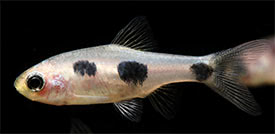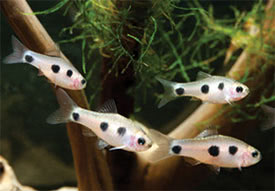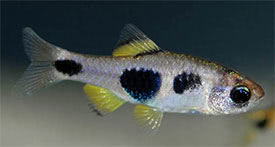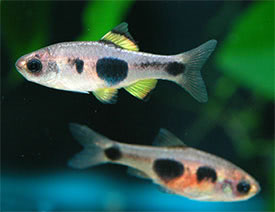
 Magyarul / Hungarian
Magyarul / Hungarian




- Scientific name: Barbus hulstaerti
- Synonyms: Capoeta hulstaerti, Puntius hulstaerti
- Common name: African Butterfly Barb
- Group: Cyprinids
- Habitat: Central Africa; Democratic Republic of Congo. Found in central parts of the Congo River drainage.
- Size: 3-3,5 cm
- Biotope: Inhabits slow-moving, shallow, shady rainforest streams and swamps where the water is stained brown because of the rotting plant matter. These waters are very soft and acidic due to tannins released by fallen leaves.
- Social behavior: A peaceful and shy fish, not really suitable for most community tanks, as they may outcompeted for food by larger fish. They should be kept in a small group. Can be kept with similar sized, peaceful fish in a community tank.
- Diet: Omnivorous; in nature they eat insects and invertebrates. In the aquarium give them small live and frozen foods, and quality dried foods.
- Breeding: Hard
- Tank: Minimum 40 litres
- Population: 8-10 fish for 50 litres
- Decoration: They look great in a densely planted tank, but a biotope setup would be better for them. Use sand as substrate, and decorate the aquarium with roots and branches. Use floating plants to dim lighting, and add some dried leaves to the tank.
- Temperature: 17-24 °C
- pH: 5-6.5
- Hardness: 1-5 NK°
- Lifespan: 2-4 years
Description: For long time the ornamental fish collections in the Democratic Republic of Congo was very hard due to the complicated political situation, so the African Butterfly Barb was rarely available in the hobby. The fish reappeared in the trade in 2006, but their price are still relatively high. Barbus hulstaerti have a silvery body with 3 blue-black spots, and the males have yellow coloration on their dorsal and anal fins.
Males are more brightly-colored especially during spawning, while females are duller in the body, lack yellow coloration in the fins and have plumper belly. African Butterfly Barb is a seasonal spawner with breeding activity occuring over two periods each year from March to June and September to November. They are egg scatterers, and the parents do not show any parental care. Temperature is very important during the spawning and hatching, as the fry’s gender depend on it. When eggs and fry are raised above 21–22 °C, the majority of the fry will be male, whereas if they are maintained within the range 17–20 °C the gender ratio will be more natural. A small aquarium (12-15 litres) is enough for breeding. Put some larger clumps of Java moss in it, and fill the tank with peat filtered water. A single pair of well-conditioned adult fish should then be introduced to the aquarium. The fish may start spawning on a daily basis in the evening. Java moss clumps are become very effective as they offer refuge for the female during spawning. The adults can be left in the breeding tank until the first free-swimming fry are noticed, usually after about 7-10 days. After another 2-3 days the fry consume their yolk sacs, and they can be fed with very small live foods. After 6-7 days they should be large enough to accept Artemia nauplii.






